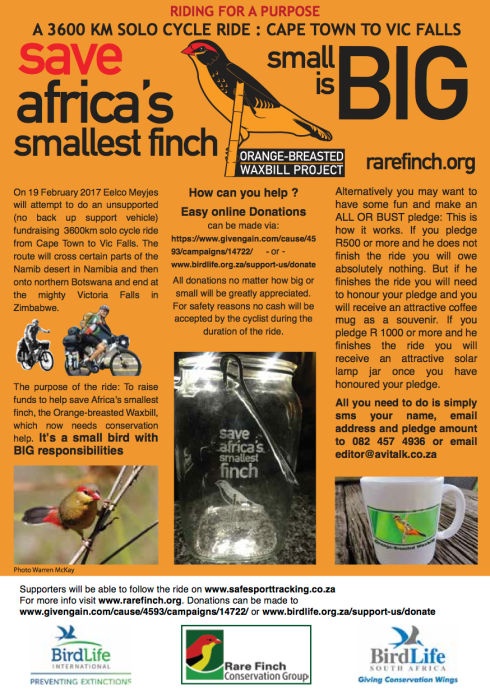 Donations can be made to http://www.givengain.com/cause/4593/campaigns/14722/ or http://www.birdlife.org.za/support-us/donate
Donations can be made to http://www.givengain.com/cause/4593/campaigns/14722/ or http://www.birdlife.org.za/support-us/donate
For more info see http://www.rarefinch.org
 Donations can be made to http://www.givengain.com/cause/4593/campaigns/14722/ or http://www.birdlife.org.za/support-us/donate
Donations can be made to http://www.givengain.com/cause/4593/campaigns/14722/ or http://www.birdlife.org.za/support-us/donate
For more info see http://www.rarefinch.org
Eureka! The Rare Finch Conservation group (RFCG) has received two new photos of a Shelley’s Crimsonwing! The photographs taken in 1996 by Morten Dehn from Denmark represent a valuable addition to the sparse visual evidence of Africa’s rarest finch.
Shelley’s Crimsonwing (Cryptospiza shelleyi) is a colourful and elusive bird. Only a few people have ever seen a Shelley’s Crimsonwing in the montane forests of the Albertine Rift Valley, where it is endemic and categorized as Vulnerable by the IUCN Red List of Threatened Species, checked on July 2016.
Although scientifically described more than 100 years ago (Sharpe, 1902), what we know about this bird is minimal, to say the least. Almost nothing is known about its natural behaviour, diet and breeding ecology. While it probably never was a very common bird, there is some evidence that the population has dramatically decreased since the 1970s; possibly because of on-going habitat destruction, but the reasons are unclear and require further investigation.
In 2005, the RFCG adopted the Shelley’s Crimsonwing as the rarest African finch to champion conservation actions and raise awareness for the Shelley’s Crimsonwing. At that time, not a single photo of a live Shelley’s Crimsonwing was known to the RFCG.
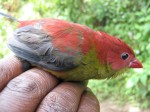
Shelley’s crimsonwing. Photo courtesy http://www.gorilla.org 2008
Simon Espley, one of the founding members, found the first known photograph of a Shelley’s Crimsonwing on the homepage of The Gorilla Foundation (www.gorilla.org). The Foundation reported that they had mist-netted and photographed a male bird in the Virunga National Park (DRC) in 2008. Subsequently during 2009 and 2010 the RFCG, with funding kindly received from the Hans Hoheisen Charitable Trust, started to do extensive fieldwork in search of Shelley’s Crimsonwing in the Bwindi Impenetrable Forest National Park (Uganda). Unfortunately, no Shelley’s were found.
However, the attention of the first known photo and the report the RFCG published and shared with various important conservation organisations helped to raise public awareness for this species, which had been flying under the radar of many ornithologists, birders and twitchers for a number of years.
As a result of this exposure, the RFCG was contacted in 2014 by Colin Jackson, from Kenya, who reported that he had mist-netted and photographed a male Shelley’s Crimsonwing in 1997 whilst on a museum field expedition primarily surveying gorillas in the Virunga National Park, DRC.Colin very kindly donated his photo of the Shelley’s to the RFCG
(http://africageographic.com/blog/the-only-two-known-photos-of-a-live-shelleys-crimsonwing/). Later, another photo of a Shelley’s Crimsonwing was uncovered by the RFCG at the renowned natural history museum, The Field Museum (Chicago, USA). Co-workers David Willard and Tom Gnoske of The Field Museum took the photo whilst on an expedition in the Rwenzori Mountains National Park in 1990 and 1991
(https://rarefinch.com/2015/10/30/a-great-new-photo-of-a-shelleys-crimsonwing/).
The two latest photographs received , as seen above, were taken by Morten Dehn, together with his colleague Lars Christiansen, whilst doing their MSc work at the University of Copenhagen, Denmark performing a survey of the altitudinal distributions of montane forest birds in the Rwenzori Mountains National Park, Uganda. During surveys between July and the beginning of December 1996, Dehn and Christiansen mist-netted birds in the Mubuku/Mahoma/Bujuku River valleys at altitudes between 2100 and 3000 m. ( These overlapped the regions surveyed by researchers of The Field Museum in 1990 and 1991.). A total of five male Shelley’s Crimsonwing were captured. One of them was photographed from two different angles ( photos 1 and 2 above). The two researchers stated that Shelley’s was by far the rarest of the four Crimsonwing species captured during their survey, which yielded only 5 out of the 76 Crimsonwing captured.( The four crimsonwing species are ; Red -Faced Crimsonwing cryptospiza reichenovii , Abyssinian Crimsonwing Cryptospiza salvadorii, Dusky Crimsonwing Cryptospiza jacksoni and the Shelley’s crimsonwing Cryptospiza shelleyi )
Like the other known photos, the bird was again hand-held when photographed. Photo 1 shows a side view, photo 2 a more unusual angle, allowing a ventral view that shows the under parts relatively well. This might be one perspective of the bird to be seen when encountered in the wild. Despite the colourful nature of the plumage, there is no doubt that the green, yellow ochre and black under parts provide good camouflage in the dense understory where the birds seem to linger most of the time. The red of the head and nape on this bird appears to be more even and continuous than what could be seen on the bird photographed by The Field Museum co-workers Willard and Gnoske in 1990 / 1991, suggesting that this may represent an older male. In particular on photo 2, the red of the head/nape really stands out and contrasts well with the greenish colour of the background. Therefore, if we were lucky enough to see a male it would probably be the red colour that would catch our attention.
Although 20 years old, the photos kindly donated by Morten Dehn are a great find and confirm that awareness for this little-known species has grown and is reaching previously unknown people who have worked on Shelley’s Crimsonwing. They are able to add valuable data to our sparse knowledge.
Interestingly, all the known photographs were taken in the 1990’s, with the exception of the male Shelley’s Crimsonwing photo taken in 2008
During 1990, a total of 25 birds were mist-netted, a number based on extensive research and publication consultation. Despite continuous efforts, the last 20 years have yielded only one male bird. Many experienced bird guides the RFCG talked to, who for many years have entered Shelley’s habitat every day, have never seen the species or say it’s extremely rare to see.
The estimated population size as stated in the IUCN Red List fact sheet for Shelley’s Crimsonwing is still 2,500 to 10,000. Conservatively, one may assume a population decline since the 1990s, based on the RFCG’s findings and conclusion after years of research and awareness campaigns.We urgently need more insights into the actual population size and distribution of Shelley’s Crimsonwing, its diet and its natural behavior to inform further conservation recommendations before this elusive and almost unknown species vanishes in silence.
Now that awareness is increasing, more people may try to take photos of a female bird, immature birds or perhaps even a nest. I cannot wait to see this.
For the RFCG: Prof. Sven Cichon, PhD (Basel, Switzerland)

Morten Dehn of Denmark, who together with Lars Christiansen did field work to survey the altitudinal distributions of montane forest birds in the Rwenzori Mountains National Park, Uganda, back in 1996 (courtesy Morten Dehn).
SEE – CONSERVE – ENJOY
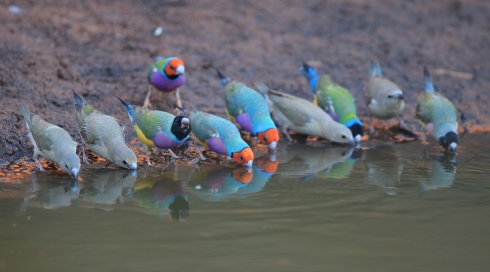
Gouldian Finches. For some finch enthusiasts these birds are considered to be the most beautiful finches in the world. These finches can be seen in northern Australia
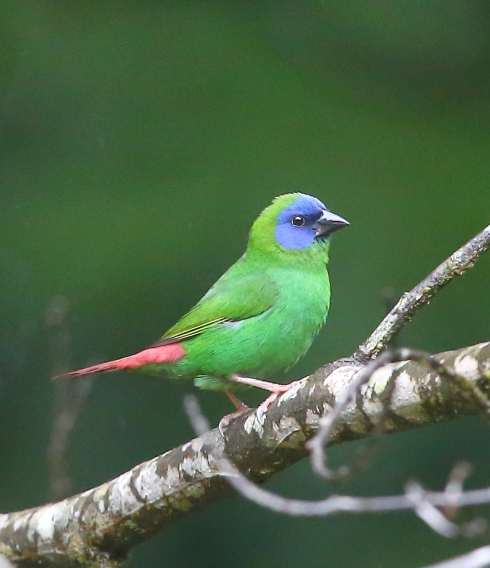
A Blue faced parrotfinch. This species can be seen in the Cape York Peninsula in north Queensland. They can also be seen in New Guinea and on many of the small islands to the north of Australia
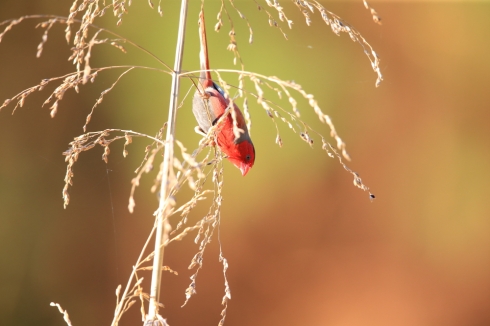
The Crimson Finch, or as some refer to it as the Blood Finch,can also be seen in northern Australia plus also the south-eastern corner of the Gulf of Carpentaria which is in Queensland
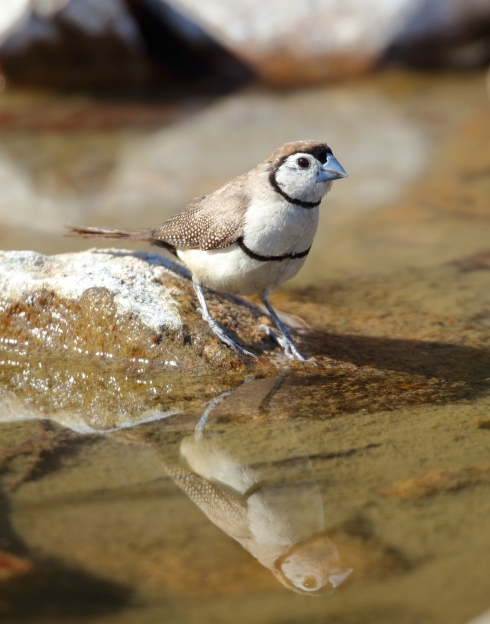
The Double-barred finch , or sometimes it’s referred to as a Bicheno or Owl finch, can be seen across a broad band from north Western Australia all the way across to north Eastern Australia.
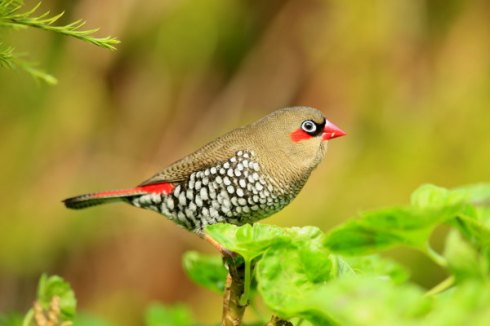
A Red-eared Firetail. This species can be seen in a very small part of south western Western Australia

The Master at Work. Col Roberts from Western Australia. Photo taken by Eelco Meyjes in the Kruger National Park on an RFCG EcoTour in 2013
This is what Col had to say about his plans for his exciting new book. ” The aim is to produce the best finch photography book primarily with anecdotes of my observations in the wild. It is not a scientific book or one containing a huge amount of text. I want to let the photos do the talking.It will be a high quality book with over 300 pages of stunning images. A lot of the photographs will show behavioral scenes such as feeding on seed heads, young etc. The book is about two years away and is scheduled for publication late 2017 / 2018.” The good news is that Col will be donating a percentage of sales to the Rare Finch Conservation Group. If you are possibly interested in putting your name down for a book please contact him at 1roberts@tpg.com.au and let him know that you read about the exciting news on our RFCG blog. At this stage it is still too early for him to give any idea on what the final cost will be. This book will undoubtedly be the definitive photographic book on all the Australian Grassfinches and Mannikins.
Col Roberts by profession is a magistrate and a full member of the Rare Finch Conservation Group. We thank him for supporting the group with his brilliant photographic work.
The Rare Finch Conservation Group is registered in South Africa as a non-profit organisation and is totally dependent on donors and sponsors to carry out its conservation work on finches in the wild. For more info visit http://www.rarefinch.org or write to the secretary at editor@avitalk.co.za
SEE – CONSERVE – ENJOY
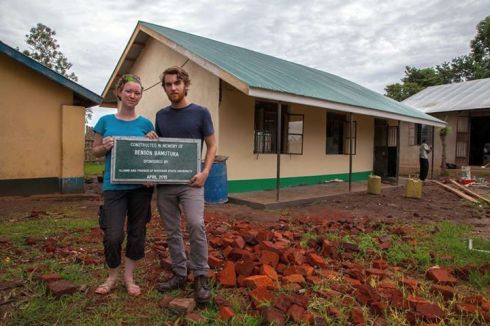
Sarah Scott and Kirk Mason , two Michigan State University alumini, in front of the completed classroom in memory of Benson Bamutura. Uganda
Last year 31 January we posted a blog with the very sad news that Benson Bamutura, who was the field manager in Uganda for the Rare Finch Conservation Group’s first field study in 2009 /10, and was one of the very few people in the world to see the elusive and threatened Shelley’s crimsonwing finch, sadly passed away on 26 January 2014. Benson left behind a young wife and three young children plus two foster children from his late sister.
On 25 June we posted a blog requesting that a fundraising initiative, started by Michigan State University to build a classroom in memory of this great bird man, be supported by our worldwide followers and supporters. An amount of 10,000 USD was needed for the project to go ahead. Well it wasn’t long before an amount of 10,630 USD was raised and construction could commence.
Last week the RFCG received the fantastic news, plus above supporting photograph, that the classroom had been completed and that his children will receive the benefit of a free education . The RFCG would like to SALUTE and congratulate the alumini from Michigan State University for spear heading the project. And thank all our followers and supporters who made a financial contribution to help this most incredible initiative become a reality.
Without Benson we would not have been able to complete our first field study in Uganda nor would we have been able to conduct our very first RFCG fund raising EcoTour
See a video clip on Benson and the Shelley’s crimsonwing finch : http://www.youtube.com/watch?v=CZ_Z5LWmyok

AFRICA’S SMALLEST FINCH
The RFCG is extremely proud to announce that BirdLife International Preventing Extinctions fully supports the recently announced BirdLife South Africa and Rare Finch Conservation Group collaboration on the little Orange-breasted Waxbill..More about the project can be read on the RFCG website http://www.rarefinch.org LATEST NEWS TAB. An exciting fund raising launch campaign to support the project will be announced in the next 3 to 4 weeks
The Rare Finch Conservation Group is a registered non-profit organisation and is totally dependent on donors and sponsors to carry out its conservation work on finches in the wild. For more info visit http://www.rarefinch.org or write to the secretary at editor@avitalk.co.za